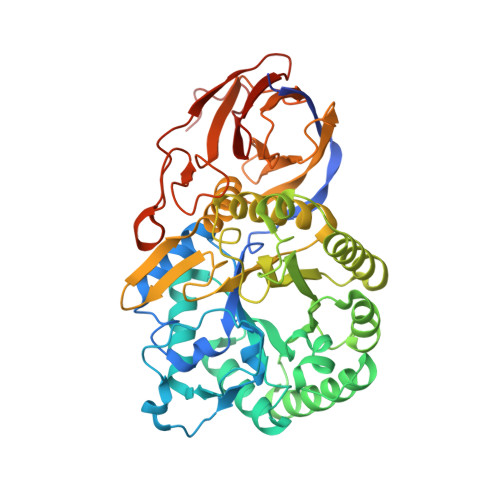Structural and biochemical characterization of glycoside hydrolase family 79 beta-glucuronidase from Acidobacterium capsulatum
Michikawa, M., Ichinose, H., Momma, M., Biely, P., Jongkees, S., Yoshida, M., Kotake, T., Tsumuraya, Y., Withers, S.G., Fujimoto, Z., Kaneko, S.(2012) J Biological Chem 287: 14069-14077
- PubMed: 22367201
- DOI: https://doi.org/10.1074/jbc.M112.346288
- Primary Citation of Related Structures:
3VNY, 3VNZ, 3VO0 - PubMed Abstract:
We present the first structure of a glycoside hydrolase family 79 β-glucuronidase from Acidobacterium capsulatum, both as a product complex with β-D-glucuronic acid (GlcA) and as its trapped covalent 2-fluoroglucuronyl intermediate. This enzyme consists of a catalytic (β/α)(8)-barrel domain and a β-domain with irregular Greek key motifs that is of unknown function. The enzyme showed β-glucuronidase activity and trace levels of β-glucosidase and β-xylosidase activities. In conjunction with mutagenesis studies, these structures identify the catalytic residues as Glu(173) (acid base) and Glu(287) (nucleophile), consistent with the retaining mechanism demonstrated by (1)H NMR analysis. Glu(45), Tyr(243), Tyr(292)-Gly(294), and Tyr(334) form the catalytic pocket and provide substrate discrimination. Consistent with this, the Y292A mutation, which affects the interaction between the main chains of Gln(293) and Gly(294) and the GlcA carboxyl group, resulted in significant loss of β-glucuronidase activity while retaining the side activities at wild-type levels. Likewise, although the β-glucuronidase activity of the Y334F mutant is ~200-fold lower (k(cat)/K(m)) than that of the wild-type enzyme, the β-glucosidase activity is actually 3 times higher and the β-xylosidase activity is only 2.5-fold lower than the equivalent parameters for wild type, consistent with a role for Tyr(334) in recognition of the C6 position of GlcA. The involvement of Glu(45) in discriminating against binding of the O-methyl group at the C4 position of GlcA is revealed in the fact that the E45D mutant hydrolyzes PNP-β-GlcA approximately 300-fold slower (k(cat)/K(m)) than does the wild-type enzyme, whereas 4-O-methyl-GlcA-containing oligosaccharides are hydrolyzed only 7-fold slower.
- Food Biotechnology Division, National Agriculture and Food Research Organization Food Research Institute, 2-1-12 Kannondai, Tsukuba, Ibaraki 305-8642, Japan.
Organizational Affiliation:



















